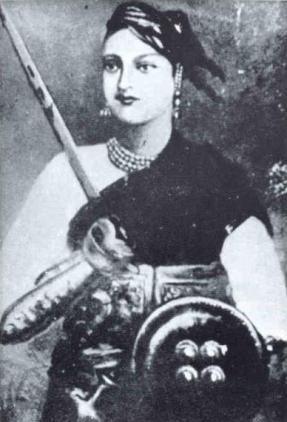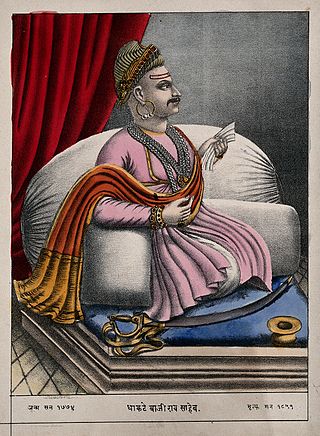
Lakshmibai Newalkar, the Rani of Jhansi or Jhansi ki Rani widely known as Rani Lakshmibai, was the Maharani consort of the princely state of Jhansi in the Maratha Empire from 1843 to 1853 by marriage to Maharaja Gangadhar Rao Newalkar. She was one of the leading figures in the Indian Rebellion of 1857, who became a national hero and symbol of resistance to the British rule in India for Indian nationalists.

Kanpur ( ), formerly anglicized as Cawnpore, is the largest city of the Indian state of Uttar Pradesh. It was the primary financial and commercial centre of Northern India. Founded in the year 1207 by a Rajput ruler Raja Kanh Deo, Kanpur became one of the most important commercial and military stations of British India. Kanpur is often regarded as the heart of Uttar Pradesh. Kanpur had been the major financial and industrial centre of North India and also the ninth-largest urban economy in India. Today it is famous for its colonial architecture, gardens, sweets, dialect, IT parks and fine quality leather, plastic and textile products which are exported mainly to the West. Kanpur is also the financial capital of Uttar Pradesh.

Major-General Sir Henry Havelock was a British general who is particularly associated with India and his recapture of Cawnpore during the Indian Rebellion of 1857.

The Indian Rebellion of 1857 was a major uprising in India in 1857–58 against the rule of the British East India Company, which functioned as a sovereign power on behalf of the British Crown. The rebellion began on 10 May 1857 in the form of a mutiny of sepoys of the company's army in the garrison town of Meerut, 40 miles (64 km) northeast of Delhi. It then erupted into other mutinies and civilian rebellions chiefly in the upper Gangetic plain and central India, though incidents of revolt also occurred farther north and east. The rebellion posed a military threat to British power in that region, and was contained only with the rebels' defeat in Gwalior on 20 June 1858. On 1 November 1858, the British granted amnesty to all rebels not involved in murder, though they did not declare the hostilities to have formally ended until 8 July 1859.

Nana Saheb Peshwa II, born Dhondu Pant, was an Indian aristocrat and fighter who led the Siege of Cawnpore (Kanpur) during the Indian Rebellion of 1857 against the East India Company. As the adopted son of the exiled Maratha Peshwa, Baji Rao II, Nana Saheb believed he was entitled to a pension from the Company. However, after being denied recognition under Lord Dalhousie's doctrine of lapse, he initiated a rebellion. He forced the British garrison in Kanpur to surrender and subsequently ordered the killing of the survivors, briefly gaining control of the city. After the British recaptured Kanpur, Nana Saheb disappeared, and conflicting accounts surround his later life and death.
Events in the year 1857 in India.

The siege of Lucknow was the prolonged defence of the British Residency within the city of Lucknow from rebel sepoys during the Indian Rebellion of 1857. After two successive relief attempts had reached the city, the defenders and civilians were evacuated from the Residency, which was then abandoned.

The siege of Cawnpore was a key episode in the Indian Rebellion of 1857. The besieged East India Company forces and civilians in Cawnpore were duped into a false assurance of a safe passage to Allahabad by the rebel forces under Nana Sahib. Their evacuation from Cawnpore thus turned into a massacre, and most of the men were killed and women and children taken to a nearby dwelling known as Bibi Ghar. As an East India Company rescue force from Allahabad approached Cawnpore, 120 British women and children captured by the rebels were butchered in what came to be known as the Bibi Ghar massacre, their remains then thrown down a nearby well. Following the recapture of Cawnpore and the discovery of the massacre, the angry Company forces engaged in widespread retaliation against captured rebel soldiers and local civilians. The murders greatly enraged the British rank-and-file against the sepoy rebels and inspired the war cry "Remember Cawnpore!".

Baji Rao II was the 13th and the last Peshwa of the Maratha Confederacy. He governed from 1795 to 1818. He was installed as a puppet ruler by the Maratha nobles, whose growing power prompted him to flee his capital Poona and sign the Treaty of Bassein (1802) with the British. This resulted in the Second Anglo-Maratha War (1803–1805), in which the British emerged victorious and re-installed him as the titular Peshwa. In 1817, Baji Rao II joined the Third Anglo-Maratha War against the British, after they favoured the Gaekwad nobles in a revenue-sharing dispute. After suffering several battle defeats, the Peshwa surrendered to the British, and agreed to retire in return for an estate at Bithoor and an annual pension.

Azimullah Khan Yusufzai also known as Dewan Azimullah Khan and Krantidoot, was the ideological leader of the Indian Rebellion of 1857. He was initially appointed Secretary, and later Prime Minister to Maratha Peshwa Nana Saheb II.

Bithoor or Bithur is a town in Kanpur district, 23.4 kilometres (14.5 mi) by road north of the centre of Kanpur city, in Uttar Pradesh, India. Bithoor is situated on the right bank of the River Ganges, and is a centre of Hindu pilgrimage. Bithoor is also the centre for War of Independence of 1857 as Nana Sahib, a popular freedom fighter who was based there. The city is enlisted as a municipality of Kanpur metropolitan area.
The Second Battle of Cawnpore was a battle of Indian Rebellion of 1857 that was decisive by thwarting the rebels' last chance to regain the initiative and to recapture the cities of Cawnpore and Lucknow.
The Central India Campaign was one of the last series of actions in the Indian rebellion of 1857. The British Army and Bombay Army overcame a disunited collection of states in a single rapid campaign, although determined rebels continued a guerrilla campaign until the spring of 1859.

The Steam House is an 1880 Jules Verne novel recounting the travels of a group of British colonists in the Raj in a wheeled house pulled by a steam-powered mechanical elephant. Verne uses the mechanical house as a plot device to have the reader travel in nineteenth-century India. The descriptions are interspersed with historical information and social commentary.
Nana Rao Park / Company Bagh is a public city park in Kanpur, the industrial hub of Uttar Pradesh, India, built after Indian independence in honor of Nana Sahib. Prior to Indian Independence the location was known as Memorial Well and commemorated the massacre of British women and children during the Indian Rebellion of 1857.

Ganesh Shankar Vidyarthi Udyan / Phool Bagh, earlierQueen's Park, is an urban city park in Kanpur, the industrial hub of Uttar Pradesh in North India. It has been the location for many public meetings and political rallies in Kanpur from the early twentieth century.

Satti Chaura Ghat or Massacre Ghat is a famous ghat in Kanpur, the industrial hub of Uttar Pradesh state in north India. It is located on the bank of the River Ganges in Kanpur Cantonment near Jajmau.

Sir Hugh Massy Wheeler KCB was an Irish-born officer in the army of the East India Company. He commanded troops in the First Anglo-Afghan War, and the First and Second Anglo-Sikh Wars, and in 1856 was appointed commander of the garrison at Cawnpore. He is chiefly remembered for the disastrous end to a long and successful military career, when his defence of Wheeler's entrenchment and surrender to Nana Sahib during the Indian Rebellion of 1857 led to the annihilation of almost all the European, Eurasian and Christian Indian population of Cawnpore, himself and several members of his family included.

Tantia Tope was a notable commander in the Indian Rebellion of 1857. He fought along with peshwa Nana Saheb in Indian freedom struggle. He is also mentioned in the series 'Bharat hain hum'.
Sir John Blick Spurgin (1821–1903) was a British army officer, a prominent figure of the Indian Rebellion of 1857.














